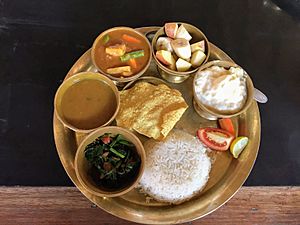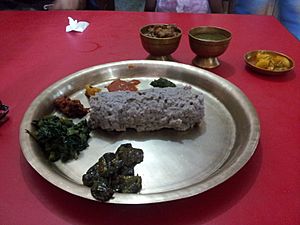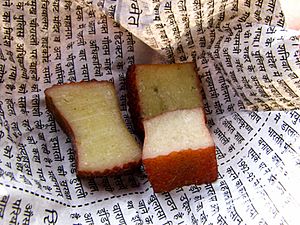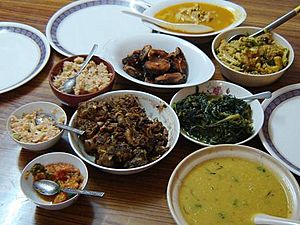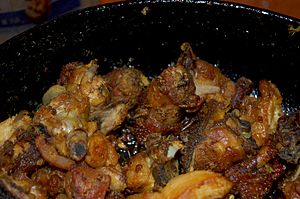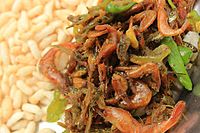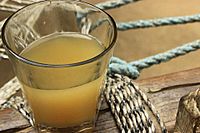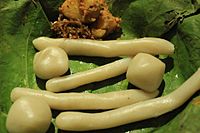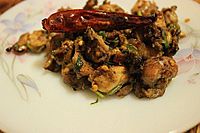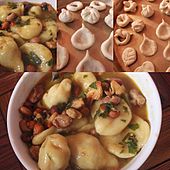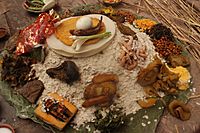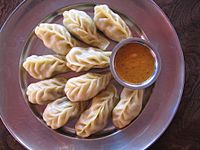Nepalese cuisine facts for kids
```wikitext Nepali cuisine is all about the delicious food from Nepal! It's super diverse because Nepal has many different ethnic groups, climates, and landscapes. The most famous meal, eaten all over Nepal, is called Dal-bhat-tarkari.
Dal is a tasty soup made from lentils and spices. Bhat is usually rice, but sometimes it can be other grains. Tarkari is a vegetable curry. People often eat these with small amounts of spicy pickles called achaar, which can be fresh or fermented. You might also find sliced lemon or lime, fresh green chili, or a crispy fried papad (a thin, disc-shaped food). Another traditional Nepali food is Dhindo (ढिंडो).

Momo are a very popular type of Nepali dumpling. They are like small pockets of dough filled with minced meat (originally buffalo, now often goat or chicken) or vegetables, and then steamed. They are a favorite snack and meal in Nepal and nearby regions.
Special foods like sel roti (a sweet, ring-shaped rice bread) are eaten during festivals such as Tihar. Many Nepali foods also have influences from Tibetan and Indian cooking.
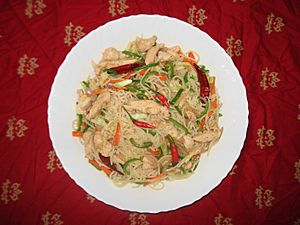
Chow mein, a Chinese-style stir-fried noodle dish, is also very popular in Nepal today. It's a common and beloved lunch for many Nepali families.
Contents
Types of Nepali Food
Food from the Hills (Khas Cuisine)
Dal-bhat-tarkari is the main meal eaten twice a day by the Khas people, who live in the hilly regions. Since there isn't always enough land for growing rice, people also eat other grains. Wheat is often made into flatbreads called roti or chapati. Maize, buckwheat, barley, or millet are often cooked into a porridge-like dish called dhido.
Tarkari (vegetable curries) can be made from fresh greens, dried greens like gundruk, white radish, potatoes, green beans, tomatoes, cauliflower, cabbage, or pumpkin.
The hilly region has a mild climate, which is great for growing fruits. Traditional fruits include mandarin oranges, kaffir limes, lemons, Asian pears, bayberries, mangoes, apples, peaches, and plums. When there are too many fruits, people preserve them by making alcohol, pickles, dried fruits, or juices.
Yogurt (dahi) and curried meat (masu) or fish (machha) are often served as side dishes. Chicken and fish are commonly eaten. Many Hindus in Nepal do not eat beef, buffalo, or yak meat. While domestic pork was traditionally eaten by some groups, wild boar is also popular.
Food from the Himalayas
Tibetan-Influenced Dishes

Himalayan food is influenced by Tibetan culture and the groups living in the high mountains. This region is very cold and not very fertile. The main crops grown here are buckwheat, millet, barley, common beans, and high-altitude rice. Potatoes are also a very important food.
Because of the cold weather, people often prefer warm foods like soups, thukpa (noodle soup), tea, and strong alcoholic drinks. Butter tea is made by mixing butter or ghyu (ghee) and salt into strong tea. This tea is sometimes mixed with tsampa flour to make a quick meal, especially for travelers.
Animals like yaks, chauries (yak and cow mixes), Himalayan goats, and sheep are raised for meat, milk, cheese, and yogurt. Since many Himalayan regions are hard to reach, rice and some spices like salt are often brought in by air or by animals.
People in this region often eat dhido (millet or barley dough), potato curry, momo, yak or goat meat, milk, thukpa, or strong alcohol like tongba (millet juice) as their regular meals. They also eat dal-bhat-tarkari when rice is available.
Thakali Cuisine
Thakali cuisine is a mix of Himalayan and lowland foods. It's eaten by the Thakali people who live in the Thak-Khola Valley, which was an old trade route through the Himalayas. This food is also served in inns along trade routes and in towns like Pokhara.
Thakali food uses less vegetables than the food from the hills. They eat meat from local sheep called Bheda and Chyangra or Chiru from Tibet. Meat is often sliced thin and dried near the cooking fire. Dried meat is added to vegetable curries or cooked in ghee and dipped in timur-ko-choup, a spicy mix of red chili powder, Sichuan pepper, salt, and local herbs. This spice mix also flavors new potatoes or eggs.
Thakali cuisine uses local buckwheat, barley, millet, and lentils, as well as rice, maize, and lentils brought from lower regions. Grains can be ground and boiled into a thick porridge eaten instead of rice with lentils. They also follow the Tibetan custom of preparing tsampa and tea with butter and salt. Ghee (clarified butter) is used in tea and for cooking.
Because many Thakali people were traders, they could get vegetables, fruits, and eggs from lower regions. They ate a wide variety of vegetables daily, some of which were dried, especially daikon radish and beetroot, often prepared with mutton. Spinach soup called gyang-to was served with a pinch of timur-ko-choup. Apples are also widely enjoyed.
Newar Cuisine
Newars are an ethnic group mainly from the Kathmandu Valley. Their culture loves food and feasts! While their daily meals are similar to other hill cuisines, Newar dishes for special occasions are much more varied. Newari cuisine uses a lot of buffalo meat. For vegetarians, fried tofu or cottage cheese can replace meat and dried fish. They also have many fermented dishes.
Some popular festival foods include Kwāti (a soup of different beans), kachilā (spiced minced meat), chhoylā (spiced and grilled buffalo meat), pukālā (fried meat), wo (lentil cake), and sapu mhichā (leaf tripe stuffed with bone marrow).
Desserts include dhau (yogurt), fruits, and mari (sweets). There are also pickles made with aamli fruit. Thwon (rice beer) and aylā (local alcohol) are common homemade drinks. Food is very important in Newari culture, and their cuisine is known for its intense flavors. They even have dishes for almost every part of buffalo meat!
Lohorung Cuisine
The Lohorung are native to eastern Nepal. They have many unique foods made from local ingredients, such as Wachipa, Wamik, Masikdaam, Sibring, Sel roti, Bawari, Dhule Achar, Saruwa, Chamre, and Dibu.
Limbu Cuisine

The Limbu have special ethnic foods like kinema (fermented soybeans), yangben (Reindeer Moss), dishes made from bamboo shoots, and bread made from millet or buckwheat. Their traditional drink is Tongba (millet beer). Pork and beef are eaten in some eastern regions like Dharan.
Terai Cuisine
Food in the Terai region (southern Nepal) includes cuisines like Maithili, Tharu, and Bhojpuri. Further west, there's also Mughlai-influenced Awadhi cuisine, especially eaten by the Muslim population around Nepalganj.
Terai diets can be more varied because more types of crops are grown locally, and cash crops are brought in from cooler hill regions. Common fruits in the Terai include mango, litchi, papaya, banana, and jackfruit.
A typical Terai meal includes basmati rice with ghee, pigeon pea daal, tarkari (cooked vegetables), tarua (battered and fried raw vegetables), papad, and mango/lemon pickles with yogurt. For non-vegetarians, fish or goat curry are common. Poultry items are also becoming popular due to urbanization.
Historically, the Inner Terai valleys were isolated, and the Tharu and Maithil people had unique diets that included hunting and gathering. With more people moving into these valleys, their diets have shifted towards more fish, freshwater crabs, prawns, and snails from rivers and ponds.
Tharu people raise chickens and traditionally hunted rats in rice paddies. Mutton is also obtained from nomadic hill people. As farming methods change, the national custom of eating rice with lentils is becoming more common. The Tharu and Maithil have special ways of preparing these staples, like rice and lentil dumplings called bagiya or dhikri.
Taro root is an important crop in the region. Both the leaves and roots are eaten. Sidhara is a mixture of taro root, dried fish, and turmeric, formed into cakes and dried. These cakes are then cooked with radish, chili, garlic, and other spices to go with boiled rice. Snails are cleaned, boiled, and spiced to make ghonghi. Other Tharu and Maithil recipes include roasted crab, wheat flatbread fried in mustard oil, and fried taro leaf cakes.
Sweets
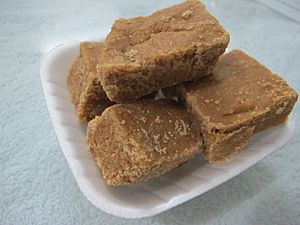
Nepal grows many fruits (like persimmons, apples, mangoes, tangerines, kiwis) and nuts that are used in local sweets. Dessert isn't always a separate course in Nepali meals; sweets made with milk, yogurt, and cheese are often eaten for breakfast as a meal on their own. Sometimes grated carrots, semolina, rice, corn, or puffed lotus seeds are used instead of flour. Barfi is a sweet made with lentils, fruits, flour, and thickened milk.
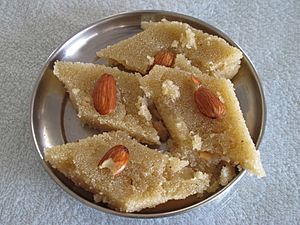
Halwa is a sweet semolina pudding with green cardamom, cashews, raisins, and shredded coconut. Like other Nepali sweets, puddings are prepared using ghee. Dumplings called lal mohan are deep-fried like fritters and soaked in sweet syrup flavored with cardamom.
During the Yomari Purnima festival in December, the Newar make sweet dumplings called yomari from rice flour, filled with sesame seeds and brown sugar or molasses. These are made to thank the goddess of grains, Annapurna, after the harvest. In this mostly Hindu country, sweet peda made with thickened milk are offered to Hindu gods.
Snacks
Snacks in Nepal include popped or parched maize called khaja (which means "eat and run"), beaten rice (baji or chiura), dry-roasted soybeans (bhatmas), and dried fruit candy (lapsi). You'll also find South Asian snacks like samosa and other sweets. International snacks like biscuits, potato chips, and wai wai (instant noodles) are also very popular, especially among young people because they are easy to find and quick to eat.
Drinks
Common non-alcoholic drinks include chiya (tea), usually with milk and sugar, sugarcane juice (sarbat), and buttermilk (mahi). Alcoholic drinks include raksi, which are spirits made in local distilleries, and jaand or jard, which is homemade beer made from rice. In higher elevations, you can find millet beer like Tongba, nigaar, and chhyaang.
Western Influence
Western culture has also influenced Nepali food. Foods like bread, cereals, bagels, pizzas, sandwiches, burgers, and pasta are common in cities and places with many tourists. Drinks like Coke, Fanta, and Sprite are also popular. Many middle-class families in cities eat these foods daily, and you can find them in almost all restaurants in urban areas.
Eating Customs
While many homes and restaurants in cities have dining tables, in villages, meals are often eaten sitting on a small wooden seat (pira) or on chairs or benches. A large amount of bhat (rice), dhindo, or a pile of rotis (flatbreads) is served on a large brass plate called a jharke thal or a compartment plate called a khande thal. On the jharke thal, the rice is surrounded by smaller portions of cooked vegetables, fresh chutney, preserved pickles, and sometimes yogurt, fish, or meat. For honored guests or elders, separate glasses and bowls are used for different dishes, often made of a special metal alloy. On a khande thal, there are separate small sections for chutney, tarkari, and other dishes.
Traditionally, food is eaten with the right hand. It's considered unhygienic and impolite to touch or eat food with the left hand. People usually wash their hands before eating and rinse their hands and mouth afterward. Using spoons and forks is becoming more common and is perfectly acceptable. If you use a spoon, washing your hands and mouth before or after isn't necessary.
In Nepal, especially among some groups, the purity of food and drinks is taken seriously. Food that has touched someone's saliva is considered jutho (impure) and might be seen as disrespectful. However, parents' jutho food is acceptable to children. Friends and spouses might share jutho food, but this depends on how traditional or religious they are. Food touched by pets or insects is usually thrown away, and the containers are thoroughly washed.
Gallery
See also
 In Spanish: Gastronomía de Nepal para niños ```
In Spanish: Gastronomía de Nepal para niños ```


